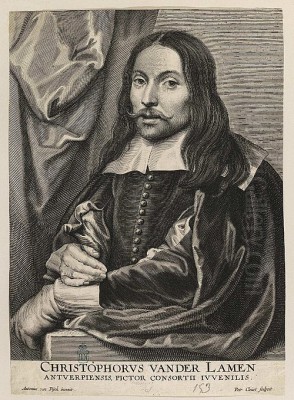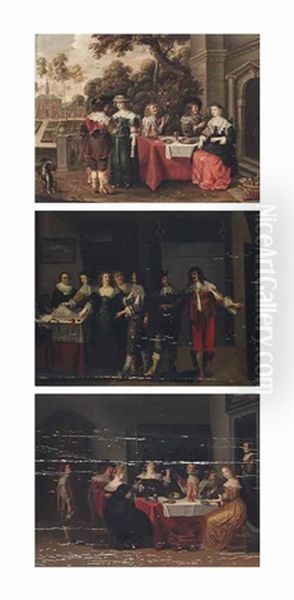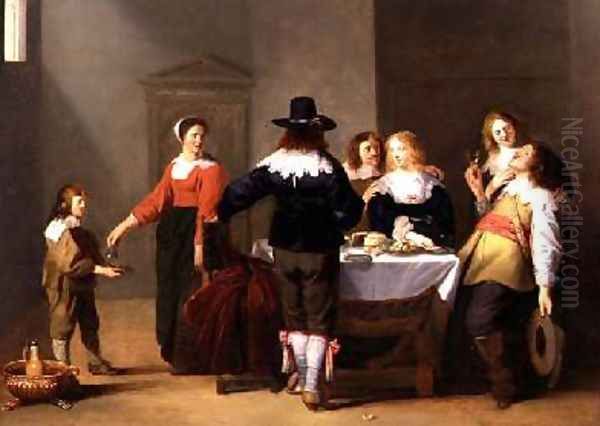
Christoffel Jacobsz. van der Lamen stands as a notable figure in 17th-century Flemish painting, particularly recognized for his lively and detailed depictions of elegant social gatherings. Active during the Dutch Golden Age, though primarily based in the Southern Netherlands (Flanders), his work captures the spirit of contemporary aristocratic and bourgeois life. Often referred to using the spelling "Christophel van der Laen" in older sources, the most widely accepted identification today is Christoffel Jacobsz. van der Lamen. Pinpointing his exact dates remains slightly challenging, with sources suggesting a birth year around 1606, possibly in Brussels or Antwerp, and a death date around 1651 or 1652, likely in Antwerp. His oeuvre provides a fascinating window into the customs, fashion, and leisure activities of the era.
Van der Lamen specialized in genre painting, specifically the popular category known as "merry companies" or geselschapjes. These works typically feature groups of well-dressed individuals engaged in various forms of amusement – dining, drinking, playing music, dancing, or engaging in games. His paintings are characterized by a refined, albeit sometimes busy, composition, meticulous attention to detail in clothing and setting, and a generally lighthearted and convivial atmosphere. He operated within a rich artistic environment, influenced by and contributing to the traditions of both Flemish and Dutch genre painting.
Early Life and Artistic Formation
Details surrounding Christoffel van der Lamen's earliest years and training are somewhat fragmented, requiring careful assembly from historical records. It is generally accepted that he was born around 1606. His birthplace is debated, with both Brussels and Antwerp cited as possibilities. Crucially, he was born into an artistic family. His father was Jacob van der Lamen, a painter documented as becoming a master in the Antwerp Guild of St. Luke in the guild year 1604/1605. This familial connection undoubtedly provided an initial immersion in the world of art.

It appears that the young Christoffel sought training beyond his father's workshop. Records suggest he traveled north to the Dutch Republic, spending time training in Amsterdam sometime before 1620. This period would have exposed him to the burgeoning art scene of the Northern Netherlands, where artists like Willem Buytewech and Dirck Hals were pioneering the "merry company" genre with a distinct Dutch sensibility. This exposure likely broadened his artistic horizons beyond the more robust Flemish traditions exemplified by figures like Adriaen Brouwer, who focused on peasant life.
After his formative years, which included this significant Dutch interlude, Van der Lamen returned south. He is documented back in Antwerp by the mid-1630s. This return marks the beginning of his mature career in the city that was still a major artistic hub, despite the towering presence of masters like Peter Paul Rubens and Anthony van Dyck having recently dominated the scene or moved abroad. Van der Lamen would carve out his own niche within this competitive environment.
Antwerp Career and the Guild of St. Luke
Upon establishing himself in Antwerp, Christoffel Jacobsz. van der Lamen formally integrated into the city's artistic infrastructure. A key milestone was his registration as a master painter in the prestigious Guild of St. Luke of Antwerp in the guild year 1636/1637. Membership in the Guild was essential for any artist wishing to practice independently, take on pupils, or sell their work legally within the city. It signified professional recognition and adherence to the standards of the craft.
His standing within the Guild seems to have been solid. In that same year, 1636/1637, records indicate he held the position of Dean ('deken') of the Guild. This was a position of leadership and responsibility, involving administrative duties and representing the interests of the painters within the Guild structure. Holding this role so soon after becoming a master suggests he was already a respected figure among his peers.
His primary period of activity spans from the mid-1630s until his death around 1651 or 1652. During these roughly fifteen years, he was a prolific painter, focusing intently on the genre scenes that would define his reputation. He operated his own workshop, contributing to the vibrant production of paintings catering to the tastes of the Antwerp market, which included wealthy merchants, nobles, and collectors seeking depictions of refined social life. While Antwerp's golden age under Rubens was perhaps waning, the city remained a significant center for art production and trade.
Artistic Style and Influences

Van der Lamen developed a distinctive style well-suited to his chosen subject matter. His paintings are typically characterized by elegantly dressed figures, often depicted in richly decorated interiors or pleasant garden settings. He paid considerable attention to the textures and details of clothing – silks, satins, lace collars, and plumed hats are rendered with care, reflecting the fashions of the time. The settings, too, often feature luxurious items like tapestries, paintings-within-paintings, ornate furniture, and fine tableware, emphasizing the status and sophistication of the depicted company.
His compositions tend to be populated with numerous figures interacting in various ways. While sometimes criticized for being overly crowded or lacking a strong central focus compared to some Dutch counterparts, this busy quality also contributes to the sense of lively social engagement. The figures gesture, converse, flirt, play instruments, or concentrate on games, creating a dynamic, if somewhat staged, tableau. The overall mood is generally one of relaxed enjoyment and civilized pleasure.
Artistically, Van der Lamen drew upon several sources. The influence of the early Dutch "merry company" painters he likely encountered in Amsterdam, such as Willem Buytewech, Dirck Hals, and perhaps Pieter Codde, is evident in the choice of theme and the depiction of contemporary social manners. However, his style retains a Flemish character, often displaying richer colors and a slightly more robust figure type than seen in the typically more restrained Dutch works.
A significant influence often cited is the Dutch painter Anthonie Palamedesz. (1601-1673), who specialized in similar elegant interior scenes, particularly guardroom scenes and companies playing games. There are clear parallels in their subject matter and compositional approaches. Furthermore, Van der Lamen worked within the broader Flemish tradition of genre painting, which had roots in the work of artists like Pieter Bruegel the Elder, though Van der Lamen focused exclusively on the upper echelons of society, unlike Bruegel or later painters of peasant life like David Teniers the Younger.
Themes and Subject Matter
The core theme running through Van der Lamen's work is the depiction of elite social life and leisure. His paintings offer glimpses into the private and semi-private world of the Flemish upper-middle class and aristocracy during the mid-17th century. He captured a range of activities that defined polite society at the time. Musical parties are a frequent subject, featuring figures playing lutes, violas da gamba, harpsichords, or singing, reflecting the importance of music in social gatherings.
Dining and drinking scenes are also common, showcasing elaborate table settings and the enjoyment of food and wine. These are not the boisterous peasant feasts of Brouwer or Teniers, but rather more decorous affairs, though still convivial. Garden parties (Buitenpartijen) allowed him to combine elegant figures with landscape elements, often depicting terraces or park-like settings where couples stroll, converse, or admire luxury objects.
Games were another popular motif. Van der Lamen painted scenes of card playing and, notably, backgammon (known then by various names, including tric-trac). His painting Jeu de gamão (Game of Backgammon), now in the Musée Ingres Bourdelle in Montauban, is a prime example. These scenes often carried subtle moralizing undertones about chance, fortune, or the potential dangers of gambling, though presented within an elegant framework.
One specific theme he addressed was the biblical parable of the Prodigal Son. His depictions, such as The Prodigal Son's Banquet or Vida dissoluta (Dissolute Life) in the Prado Museum, focus on the episode where the son wastes his inheritance on riotous living, often shown as a lavish feast with music and questionable company. This theme was popular across Europe in the 17th century, appearing in paintings, prints, and theatre, serving as both entertainment and a moral warning against extravagance and vice.
While his focus was on elegance, some contemporary and later critics noted elements that could be considered "low-life" intruding into these refined settings – excessive drinking, gambling, and flirtatious behaviour. This blend perhaps reflected the realities of social life more accurately than purely idealized depictions might suggest, but it also led to some criticism regarding the perceived lack of high moral seriousness in his work compared to history painting or portraiture.
Representative Works
Several key works exemplify Christoffel van der Lamen's style and thematic concerns. While precise dating is often difficult, these paintings showcase his characteristic approach:
Elegant Company Eating, Drinking and Music-Making: This title, sometimes applied to variations of similar scenes, captures a core subject. One such work (panel, 49 x 64 cm), formerly in a private collection, depicts figures around a table laden with food and drink, while others play music or converse in a garden setting. It highlights the blend of indoor and outdoor leisure activities.
A Gathering in the Garden / A Garden Party: Represented by works like the panel (52 x 64.5 cm) formerly in Swiss and South German private collections, these paintings emphasize outdoor socializing. Figures in fashionable attire are shown interacting within manicured garden landscapes, embodying the ideal of refined pastoral leisure.
Jeu de gamão (Game of Backgammon): Housed in the Musée Ingres Bourdelle, Montauban (panel, 48.5 x 65 cm), this painting focuses on the intensity and social dynamics surrounding a game of backgammon. It showcases Van der Lamen's ability to capture specific activities and the interactions they generate among participants and onlookers.
The Prodigal Son Wasting his Fortune ('Repast do Prinkerode' / 'Vida dissoluta'): Several versions exist, including the notable example in the Museo Nacional del Prado, Madrid (panel, 57 x 83 cm), titled Vida dissoluta. Another version, possibly related, is in the Louvre Museum, Paris (Inv. 20384, panel, 71.5 x 104 cm), sometimes identified by the old title Repast do Prinkerode. These works depict the height of the son's wasteful extravagance in a bustling scene of feasting, music, and morally dubious company.
Interior Scene ('Cena de interior'): A work described with this title (panel, 43 x 64 cm) was historically documented, possibly the one once held in the Musée du Luxembourg or similar collections (though its current location may be unknown). Such scenes typically show groups engaged in conversation, music, or games within well-appointed rooms, showcasing Van der Lamen's skill in rendering interiors and the interplay of figures within them.
These examples demonstrate the consistency of Van der Lamen's focus on elegant social gatherings, his detailed rendering of costumes and settings, and his contribution to the popular genre of "merry company" painting in the Southern Netherlands.
Workshop, Students, and Collaborations
Like most successful painters of his time, Christoffel van der Lamen likely maintained an active workshop in Antwerp to meet the demand for his popular scenes. Running a workshop involved employing assistants and training apprentices, who would learn the master's style by copying his works and assisting in the production of new paintings. This practice was standard within the Guild system.
The most well-documented pupil of Van der Lamen is Hieronymus Janssens (1624-1693). Janssens entered Van der Lamen's workshop around 1636/37, the same year Van der Lamen became a master and Dean of the Guild. Janssens himself became a master in the Antwerp Guild in 1643/44. He clearly absorbed his master's interest in elegant social scenes but developed his own specialty, becoming known as "Den Danser" (The Dancer) for his frequent depictions of balls and dancing figures, often set in palatial interiors or terraces. Janssens' career demonstrates the direct lineage and influence of Van der Lamen's teaching. While other students may have passed through his workshop, their names are not as clearly recorded.
Collaboration between artists was also common in 17th-century Antwerp, with specialists often contributing elements to each other's paintings (e.g., a figure painter adding staffage to a landscape by another artist). Some sources tentatively suggest potential collaboration between Van der Lamen and Frans Francken the Younger (1581-1642), a prolific painter from a large family of artists, known for his detailed small-scale history paintings and allegorical scenes, sometimes including elegant figures. However, concrete evidence for specific joint works is often lacking.
Van der Lamen worked alongside numerous other talented genre painters active in Antwerp during his time. Figures like Gonzales Coques (1614/18-1684), known as the "little Van Dyck" for his elegant small-scale group portraits that border on genre scenes, represent a related but distinct approach to depicting refined society. The broader artistic milieu included landscape painters, still life specialists, and history painters, all contributing to Antwerp's diverse art market.
Later Reputation and Legacy
Christoffel Jacobsz. van der Lamen enjoyed considerable success during his lifetime, catering to a clear market demand for his elegant and lively social scenes. His paintings captured a specific facet of 17th-century Flemish culture – the leisure and refinement of the upper classes. The popularity of his themes is further evidenced by the fact that his compositions were sometimes disseminated through prints, which helped spread his imagery to a wider audience across Europe.
His influence is most clearly seen in the work of his pupil, Hieronymus Janssens, who carried forward the tradition of depicting elegant gatherings, albeit with a greater focus on dance. Through Janssens and potentially others, Van der Lamen's approach to the "merry company" genre contributed to its continuation in Flemish art. His works were also collected abroad; evidence suggests his paintings found appreciation in France, even during the later era of Louis XIV, known for its own distinct artistic tastes.
However, Van der Lamen's critical reception has fluctuated. While appreciated for their charm, detail, and historical insight into period manners and dress, his works have sometimes been viewed as less profound or compositionally sophisticated than those of the very top tier of Dutch genre painters like Johannes Vermeer or Gerard ter Borch, who often achieved greater psychological depth or compositional harmony. Compared to the boisterous, satirical, and often more complex narratives of Jan Steen, Van der Lamen's work appears more straightforwardly decorative.
Despite these comparisons, Van der Lamen holds a secure place in art history as a significant practitioner of the elegant company scene in the Southern Netherlands. His paintings remain valuable documents of their time and place, offering a visually rich portrayal of social interaction and material culture. His works continue to appear on the art market and are held in major museum collections, including the Louvre, the Prado, and the Musée Ingres Bourdelle, attesting to their enduring appeal and historical importance.
Conclusion
Christoffel Jacobsz. van der Lamen was a skilled and productive painter who specialized in capturing the convivial atmosphere of 17th-century Flemish elite society. Working primarily in Antwerp during the Dutch Golden Age, he distinguished himself with detailed and lively depictions of "merry companies" engaged in music, games, dining, and conversation. Influenced by both Dutch and Flemish traditions, and notably by artists like Anthonie Palamedesz., he developed a recognizable style characterized by elegant figures, rich settings, and meticulous attention to fashion and detail.
Through his role as a master in the Guild of St. Luke and as a teacher to pupils like Hieronymus Janssens, Van der Lamen contributed actively to the artistic life of Antwerp. His representative works, found today in major European museums and private collections, serve as valuable records of the social customs and aesthetic preferences of his era. While perhaps not reaching the heights of innovation or profundity of some of his Dutch contemporaries, Christoffel Jacobsz. van der Lamen remains an important figure for his dedicated chronicling of elegance and leisure in the Flemish Baroque period. His paintings continue to offer viewers a charming and informative glimpse into a bygone world of refined pleasure.